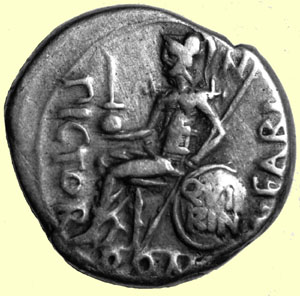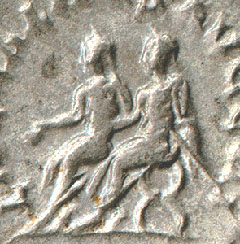 Contents -
Previous Article -
Next Article
Contents -
Previous Article -
Next Article
The Kings of Early Rome
Seven Legendary Kings Ruled Early Rome Before the Founding of the Republic in 509 B.C.
The early history of Rome has always been an interesting mixture of heroic legend and fact. Archaeological evidence indicates that there were people living on the Palatine and nearby hills prior to 1000 B. C. The Palatine is where one of the earliest Latin settlements grew up that later became the city of Rome. According to tradition, Rome was founded in 753 B.C. by Romulus, who became the first Roman king and gave his name to the city. Rome was ruled by seven legendary kings from 753 B.C. until 509 B. C. when Tarquin the Proud was overthrown by the Roman people and a republic was established. Because of the abuses of the Tarquins, Romans have always hated the very idea of a king and royalty. Even after the time of Augustus and other First Century A. D. emperors, none of these rulers dared call himself "King" for fear of raising the wrath and indignation of the Roman people. They simply went by the title of Princeps, meaning First Citizen or Pater Patriae, meaning Father of His Country.
 The king would dress in a purple trimmed cloak and high - topped boots of red leather. He sat upon a throne of ivory known as a curule chair. These are often seen in reliefs and on the reverse of coins and were constructed using crossed elephant tusks for legs. The kings were accompanied by twelve lictors as he traveled about the city. The lictors each bore a fasces, a bundle of rods which symbolized the power over life and death held by the King of Rome. The axe symbolized the power to execute quicly and mercifully, while the rods symbolized the power to punish with beatings. Though the king was commander in time of war, chief priest, and judge, he did not have absolute power when it came to governing Rome. He needed the agreement of a governing body in order to Make such important decisions as whether or not to go to war. The Comitia Curiata was formed of representatives from each of the thirty curiae, or groups of family clans. If approved by the Comitia Curiata, the act still had to be approved by the Senate, originally one hundred of Rome's wealthy men who served as advisors to the king.
The king would dress in a purple trimmed cloak and high - topped boots of red leather. He sat upon a throne of ivory known as a curule chair. These are often seen in reliefs and on the reverse of coins and were constructed using crossed elephant tusks for legs. The kings were accompanied by twelve lictors as he traveled about the city. The lictors each bore a fasces, a bundle of rods which symbolized the power over life and death held by the King of Rome. The axe symbolized the power to execute quicly and mercifully, while the rods symbolized the power to punish with beatings. Though the king was commander in time of war, chief priest, and judge, he did not have absolute power when it came to governing Rome. He needed the agreement of a governing body in order to Make such important decisions as whether or not to go to war. The Comitia Curiata was formed of representatives from each of the thirty curiae, or groups of family clans. If approved by the Comitia Curiata, the act still had to be approved by the Senate, originally one hundred of Rome's wealthy men who served as advisors to the king.
The curious fact of Roman history is that no written records dating to before 350 B.C. have been found. After that time, records began to be kept by the priests, the Consuls' names were recorded, and laws were written down. Later three men, Ennius, Naevius and the famous historian Q. Fabius Pictor began to write histories based on ancient legends and their own records of current events. Because of this, the seven kings of Rome possess a status somewhere between legendary and historical. There probably were seven kings bearing these names, but the events ascribed to their reigns before Servius Tullius are probably legendary and allegorical in character. The warlike character of Tullus Hostilius stands in contrast to the religious emphasis on the events in King Numa's reign. The following is a list of Rome's early kings and a brief description of the reign of each.
Romulus
753 - 715 B.C.
Romulus was the legendary founder of Rome. He occupies a unique place in Roman history. There is no archaeological or contemporary written legend to indicate that a real king named Romulus actually lived. One legendary event said to have taken place during the reign of Romulus was the Rape of the Sabine Women. About six months after Rome was founded, the Roman men discovered that they were having a difficult time finding wives. The citizens of surrounding towns did not want to betroth their daughters to the warlike Romans for fear that the Romans would become too powerful and conquer them. In desperation, the Romans entered the town of the Sabines by night and kidnapped the young Sabine women, who did not seem to object too strongly to the idea! The Sabines declared war on the Romans to get their daughers back, but were not successful. The Romans had the Sabine fathers across a barrel. If they ever wanted to get their daughters back, they would have to accept the Romans as their sons - in - law. Soon, they came to an accord. The Sabine fathers agreed to allow the Roman men to properly marry their daughters. Each Roman man gained a good, faithful wife. The Sabine fathers gained sons - in - law of hardy Roman stock, and a great wedding celebration was enjoyed by all. As in all legendary events in Rome's history, there is a symbolic character to this tale. Rome was busily uniting the towns of Latium into a strong confederacy under her leadership that could withstand attack from other strong tribes in central Italy. The Rape of the Sabine Women symbolized the Roman desire to make alliances with neighboring towns, by invitation if possible.
Numa Pompilius
715 to 672 B.C.
Numa Pompilius was the king who established the priesthoods and religious institutions of the Romans. His reign was a peaceful one compared with that of Tullius Hostilius who succeeded him.
Tullius Hostilius
672 - 641 B.C.
Tullius Hostilius was famous for his warlike exploits. He conquered much surrounding territory and added it to the growing area of land ruled by Rome. During his reign a long, drawn - out war was fought between Rome and Alba Longa. Rome eventually won and vanquished her rival city. The reign of Tullius Hostilius symbolizes the ambitious and warlike nature of the Roman people.
Ancus Marcius
641 - 616 B.C.
Lucius Tarquinius Priscus
616 - 578 B.C.
Servius Tullius
578 - 534 B.C.
Tarquinius Superbus
534 - 510 B.C.
The last of the Tarquins to rule Rome was Tarquinius Superbus. His name translates in English as Tarquin the Proud. Three Tarquins ruled the city-state of Rome during its early years. Tarquinius Superbus was driven out of Rome and the Republic was established in 509 B. C.
The coin reverse shown above bears the inscription of N. Fabius Pictor, a Roman moneyer from about the year 126 B.C. This is almost identical to one struck by the famous Q Fabius Pictor, one of the first historians to produce a written record of Roman history. The coin is catalogued as Fabia 11 in Roman silver Coins by Seaby.
Go to next article:
Go back to previous article:
Return to Table of Contents
 The king would dress in a purple trimmed cloak and high - topped boots of red leather. He sat upon a throne of ivory known as a curule chair. These are often seen in reliefs and on the reverse of coins and were constructed using crossed elephant tusks for legs. The kings were accompanied by twelve lictors as he traveled about the city. The lictors each bore a fasces, a bundle of rods which symbolized the power over life and death held by the King of Rome. The axe symbolized the power to execute quicly and mercifully, while the rods symbolized the power to punish with beatings. Though the king was commander in time of war, chief priest, and judge, he did not have absolute power when it came to governing Rome. He needed the agreement of a governing body in order to Make such important decisions as whether or not to go to war. The Comitia Curiata was formed of representatives from each of the thirty curiae, or groups of family clans. If approved by the Comitia Curiata, the act still had to be approved by the Senate, originally one hundred of Rome's wealthy men who served as advisors to the king.
The king would dress in a purple trimmed cloak and high - topped boots of red leather. He sat upon a throne of ivory known as a curule chair. These are often seen in reliefs and on the reverse of coins and were constructed using crossed elephant tusks for legs. The kings were accompanied by twelve lictors as he traveled about the city. The lictors each bore a fasces, a bundle of rods which symbolized the power over life and death held by the King of Rome. The axe symbolized the power to execute quicly and mercifully, while the rods symbolized the power to punish with beatings. Though the king was commander in time of war, chief priest, and judge, he did not have absolute power when it came to governing Rome. He needed the agreement of a governing body in order to Make such important decisions as whether or not to go to war. The Comitia Curiata was formed of representatives from each of the thirty curiae, or groups of family clans. If approved by the Comitia Curiata, the act still had to be approved by the Senate, originally one hundred of Rome's wealthy men who served as advisors to the king.
 Contents -
Previous Article -
Next Article
Contents -
Previous Article -
Next Article